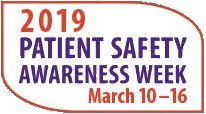When it comes to patient safety, nurses stand bold as patient advocates. With so much going on and so many people involved in caring for a patient, the potential for something to go wrong is always present. Nurses help prevent that from happening.
This week Patient Safety Awareness Week (March 10 – 16) highlights the importance of patient safety and how healthcare staff and patients and their families can take steps to safeguard against mishaps.
Patients today enjoy more patient safety standards and protocols than patients did even a decade ago. Even the simplest protocol of hand washing has made inroads into protecting patients and healthcare providers from acquiring infections and additional germs. But healthcare today is also much more complex than it ever used to be. Patients have more complex conditions and comorbidities. Progress in treatment means that treatment plans are more extensive and likely involve more medication and/or monitoring.
All of these advances contribute to better treatment and care, but also open up the potential for issues like drug interactions, a missed new symptom, or even a patient who feels good enough to make it to the bathroom alone and exposes a potential fall hazard. In fact, the Institute for Healthcare Safety states that some studies report nearly 400,000 U.S. deaths from medical errors. And that doesn’t include figures for those who are harmed while under medical care.
Nurses provide a fact-checking stance where they can double and triple check medications for the correct med, dosage, timing, and for any drug interactions. They are also the providers who constantly assess a patient’s physical appearance. They can look for breathing changes or skin color changes or injuries on the skin. They are there to talk with a patient and notice any speech changes or cognitive changes that could raise a red flag. They are even there to make sure ill patients are not overwhelmed by visitors.
The Institute for Healthcare Improvement (IHI) and the National Patient Safety Foundation (NPSF) offers excellent and plentiful resources for healthcare providers concerning patient safety. One of the toughest situations is when patients leave a facility to go home, and nurses rightly worry about their home environment and the care they will receive there. This PDF, Engaging Patients and Families in the Safest Care (excerpted from The National Patient Safety Foundation’s Lucian Leape Institute report Safety Is Personal) helps nurses offer realistic and accurate guidelines for continuing patient safety in the home environment.
To help celebrate this week, nurses can make efforts to learn as much as they can about improving patient safety. The IHI is offering a free webinar on March 13 Advancing Patient Safety Beyond the Hospital for those looking to find out more information on how they can help keep patients safe.
- WOC Nurses Week Highlights Specialty - April 16, 2024
- Honoring Radiology Nurses Day on April 12 - April 12, 2024
- Travel Offers New Career Possibilities - April 8, 2024



